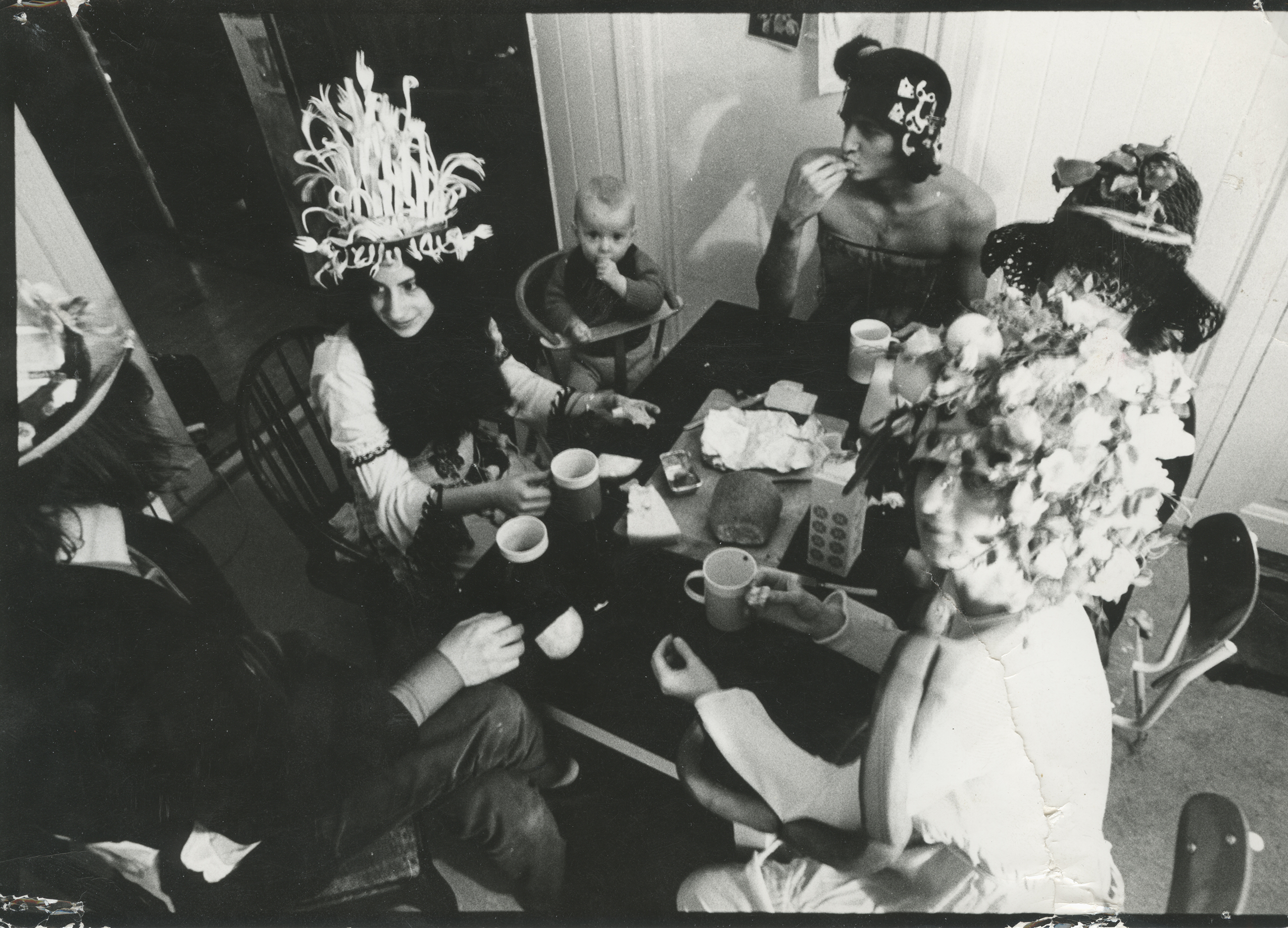Gruppe 66
Artists: Elsebeth Rahlff, Anne Hedegaard, Gitte Dæhlin, Trond Kastmann, Laurie Grundt
In the late 1960s and 1970s, a Bergen-based group of artists came together in response to what they deemed cultural and institutional complacency. Gruppe 66 did not set out merely to reflect their time: they sought to transform it. Their united practice came without a unified aesthetic and, instead, was grounded in participation, embodiment, and collectivity, driven by care and dissent in kind. Their audiences were therefore neighbours, collaborators, and active contributors to various art forms.
The artists in Gruppe 66 explored participatory strategies of being and making together. They utilised the Scandinavian Situationists’ concept of co-ritus — a portmanteau of the words for ‘collective’ and ‘rite’, which describes a collective and social approach to artmaking — first introduced to Gruppe 66 during their 1966 collaboration with Danish avant-garde artists. Co-ritus functions as an improvised ritual rather than a static object: an open-ended, communal endeavour that enacts dissent.
In this edition of Bergen Assembly, Adania Shibli in collaboration with curator Frode Sandvik from Kode, Bergen Art Museum, returns three seminal exhibitions by Gruppe 66, all of which were held at Bergen Kunsthall: Gruppe 66 (1966), Konkret Analyse (1970), and Common Life/Samliv (1977–78).
The eponymous exhibition Gruppe 66 directly intervened with the cultural status quo. Alongside the display of art — much of which was intentionally ephemeral to avoid ideas of monumentalism — evening event programmes fostered gathering, dialogue, and actions concerned with working conditions for artists in Bergen, the need for an art academy, and the lack of studios and exhibition spaces. Konkret Analyse extended these ideas by assembling artists and thinkers in an open research project that mixed abstraction with gesture, humour with analysis. Performance, sculpture, video, and costume were used to investigate questions of embodiment, social structure, and symbolic language. A number of years later, Common Life/Samliv featured theatre scripts, textiles, workshops, and printed materials, all of which were made in mobile classrooms. These represented a radical fusion of art and learning, with artists, art students, medical students, and public health workers collaborating to address taboo topics such as sex education, contraception, and disease — shifting shame into knowledge.
Now, half a century later, a selection of their work comes back to Bergen Kunsthall in the very rooms where these experiments first took shape. This is not a retrospective but a proposition: to learn with their methods, and to engage with art as a rehearsal for unity in common life, defined by sharing not showing.
In addition to displaying some of the works originally shown at the time, documentation of events, posters, and exhibition activities are brought together to underline how these exhibitions ultimately became spaces for collective action.
Furthermore, over the course of the exhibition a series of four new co-ritus events resumes the practice of Gruppe 66, not as an elegy to the past, but as a consideration for a future engagement in which cooperation and interaction with the audience are central. The invited artists and collectives will engage in a process over one evening that includes durational traces and is shaped by encounter and sharing.
co-ritus by: Susan Philipsz, Maasai Mbili, Jakkai Siributr, and Tenthaus Art Collective
11 September, 17:00: Susan Philipsz
18 September, 17:00: Maasai Mbili
30 October, 17:00: Jakkai Siributr
6 November, 17:00: Tenthaus
Convenor: Adania Shibli
Curatorial Advisor: Frode Sandvik
Developed in close dialogue with Elsebet Rahlff and Knut Ove Arntzen
In partnership with: KODE
With support from: Sixten and Espen Rahlff
Gruppe 66, Bergen Kunsthall, 11.03–3.04.1966
Gruppe 66: Niels Bolstad, Egil Røed, Lasse/Laurie Grundt, Elsebet Rahlff, Olav Herman Hansen, Ingvald Holmefjord, Oddvar Thorsheim, Per Kleiva, Terje Skulstad, Kjetil Hvoslef, Bjørn Kahrs Hansen, Ragnhild Gram Knutsen, Knut Bratland Kristiansen, Bjørn Hegranes, and Lars A. Sæverud.
Invited guest participants from Copenhagen: Jens Jørgen Thorsen (painter, filmmaker, art historian, Situationist, and member of the Scandinavian Situationists at Drakabygget, Sweden), Walt Rosenberg (actor and performer from the Royal Danish Theatre, Copenhagen), Anne Hedegaard (textile artist), and Stefan Rink (multimedia artist).
Konkret Analyse, Bergen Kunsthall, 2.10–18.10.1970
Participants: Laurie Grundt and Stefan Rink (concept and organisers); Olav Herman Hansen, Anne Hedegaard, Elsebet Rahlff, Oddvar Thorsheim, and Niels Bolstad (all from Gruppe 66); and art student assistants Kim Schwartz and Bodil Lundsteen, all contributing with artworks, films, poetry, installations, events, happenings, jamming, debates, etc.
Scandinavian guest participants: Kjell Skyllstad (composer/conductor, Oslo), Ole John (experimental filmmaker, Copenhagen), Timo Linnasalo (experimental filmmaker, Helsinki), Kari Rydman (musician and composer, Helsinki), Jacqueline Buch & Co. (puppet theatre, Copenhagen), Sixten Haage (sculptor, Sweden), Marius Heyerdal (sound sculptor, Norway), Terkel Hedegaard (painter and multimedia artist, Copenhagen), Church Underground (Helsinki), and Day of Phoenix and King Kong (rock band and lightshow, Copenhagen).
Common Life/Samliv, Bergen Kunsthall, 28.01–16.02.197
Co-organised by Inger Grundt and Elsebet Rahlff. The project featured more than 50 contributors.
What’s on?
No scheduled events
View full programme-
Bergen Kunsthall
Rasmus Meyers allé 5
5015 BergenTuesday–Wednesday: 11:00–17:00
Thursday: 11:00–20:00
Friday–Sunday: 11:00–17:00
